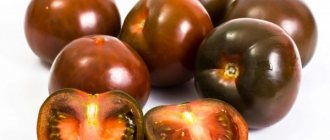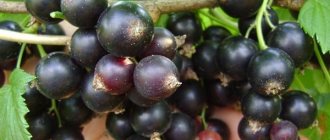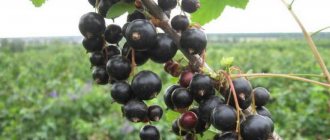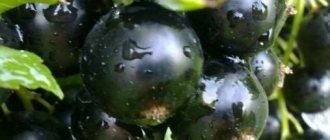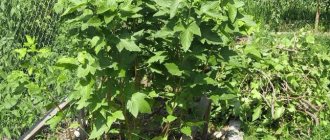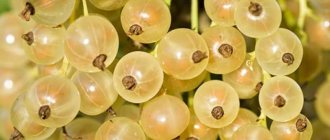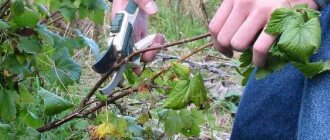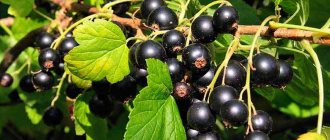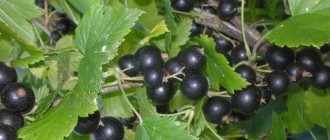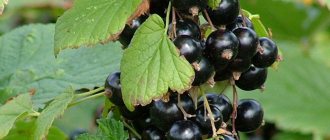Blackcurrant Titania is one of the most popular varieties of foreign origin. It consistently produces high yields, and has received only positive reviews among gardeners. The description of the variety with a photo shows the main characteristics of the berry bush, and if certain conditions are met during planting and care, then you can count on the appearance of berries the very next year after the start of cultivation.
Description of Titania currant
Titania develops well and bears fruit well in any region of Russia, excluding areas with the coldest winters. The variety is considered average in terms of frost resistance, but it tolerates sudden thaws and spring return colds better than others.
Important! Bryansk breeders experimentally established the superiority of Titania over other blackcurrant hybrids. It produced the greatest yields under unfavorable environmental factors.
The Titania currant variety is characterized by rapid growth and quickly begins to bear fruit. Mature plants form a dome-shaped crown and reach 1.5 m in height. The shoots tend upward as they grow, forming a dense bush that requires regular thinning.
The stems are thick, light green in color, and give good growth over the season. The leaves are slightly wrinkled, large, and grow densely.
Description of Titania currant berries:
- large clusters consist of 20 or more fruits;
- ripe Titania berries are black, with a slight shine;
- the size of the fruits is uneven: from very large to small at the ends of the clusters;
- the average weight of a ripe berry is 2.5 g;
- the pulp is green, not watery;
- the skin is dense and elastic.
The ripe fruits of Titania do not fall off the bush, which smoothes out the inconvenience of uneven ripening of the berries. The elastic skin and thin stalk ensure dry tearing when harvested.
Harvesting and preparing for winter
The fruits ripen on Titania in waves, so they are harvested only 3-4 times throughout the summer. Although the bunches are heavy, the bushes can withstand the load well and do not break. The collected fruits are sorted from garbage, washed and processed. If transportation or long-term storage is intended, then there is no need to wash it, this will only reduce shelf life.
After fruiting, with the arrival of autumn, the bushes are pruned, the ground is watered, and after a few days a mulch mixture consisting of peat, humus or sawdust is laid. With such shelter, currants are able to overwinter in regions where the temperature does not drop below -20 degrees. In more severe climates, the branches are collected and tied into a bundle, and then wrapped in agrofibre and fixed.
Attention! You cannot use film for covering because it does not allow air to pass through.
Characteristics of the variety
Judging by the reviews, black currant Titania is a variety that begins to bear fruit early. The first berries begin to appear in the second year of the plant’s life. The yield of black currant increases up to 7 years, then it decreases. The first 15 years of a bush’s life are productive. The number of fruits directly depends on care, soil condition, and weather conditions.
Drought resistance, frost resistance
Black Titania is a very resilient currant. Its bushes adapt to any climatic conditions and easily tolerate unexpected weather conditions. According to the description of the variety, Titania currants are able to survive winters with frosts exceeding -34 °C.
If damaged by spring frosts or a thaw followed by cold weather, Titania loses only 25% of the average harvest. Summer residents claim that without watering and pruning, in abandoned areas, bushes continue to bear black berries for decades.
The dense, leafy bush of Titania tolerates heat well, and the root system can withstand prolonged drought.
Productivity and fruiting
Titania is a medium-early ripening variety. The bushes bloom in the second half of May. After 40 days, the first black fruits appear at technical maturity. In July, the harvest period begins, which can last more than 30 days.
Black, ripe fruits are removed every 10 days, green ones are left on the branches. The final yield depends on the care and age of the bushes. On average it is:
- 2 kg from a young bush;
- from 8 to 10 kg per plant over 5 years old;
- An old or unkempt bush gives about 3 kg.
Taste characteristics of black Titania berries:
- sugars – 6.6%;
- acids – 3.2%;
- expert assessment – 4.6 points out of 5.
Important! The taste of Titania is highly dependent on soil moisture. With heavy watering or prolonged rains, black berries become more sour.
Area of application of fruits
According to reviews, not everyone likes the sour taste of Titania blackcurrant. The classic wine aftertaste and strong aroma are used in the production of light alcoholic drinks, juices, syrups, in confectionery production, and in canning. Black currants tolerate freezing well and retain their aroma when dried.
The dense pulp and elastic skin of Titania allow blackcurrants to be harvested by machine. Combined with excellent shelf life (up to 2 weeks) and transportability, this makes the crop very popular among farmers.
At home, black berries can be stored in the refrigerator for more than 10 days.
Resistance to diseases and pests
The official description of Titania currant indicates the ability to resist the following fungal infections:
- powdery mildew;
- anthracnose (bitter rot);
- white and brown spotting.
Advantages and disadvantages of the variety
The undoubted advantages of the variety are:
- Stable yield.
- Resistance to frost and heat.
- Immunity to “currant” diseases.
- Presentable appearance, keeping quality, ease of harvesting.
Disadvantages of Titania according to gardeners:
- rapid thickening of bushes;
- in one cluster there are fruits of different sizes;
- The taste of the berries is sour.
Some people consider extended fruiting periods to be a disadvantage for black currants, while others consider this property to be an important advantage of the variety.
Important! The self-fertile Titania currant produces good yields even in conditions of insufficient pollination. No partner plants are required for the culture.
Origin story
There are about 200 officially registered varieties of blackcurrant. But breeders are trying to obtain a plant with high resistance to diseases, weather disasters and high yield. The taste of the berry is important.
Outdated varieties had sour and small berries. With the advent of modern varieties with large and sweet berries, currants have finally won the hearts of gardeners.
Titania currant was bred more than 40 years ago by Swedish breeders. Botanists crossed the famous “Altai dessert” with their native variety “Kajaanin Musta-Tamas”. The variety has been officially registered since 1970. The berry appeared on private plots in the late 90s.
But Titania was officially recognized as one of the best varieties in 1997–1999. Scientists from the Bryansk Research Institute conducted tests for adaptation and productivity of 180 varieties of black currant of domestic and foreign selection.
Titania outperformed the varieties from Altai and Belarusian breeders in terms of yield. Under favorable conditions, Titania's yield is about 80 c/ha or 4-5 kg per bush. The berry is slightly inferior in composition to the Minai Shmyrev variety. Vitamin C in Titania is 202 mg, which is 10 mg less than in Minai Shmyrev.
In 1999, varieties were also tested under unfavorable conditions. In winter, during thaws, many bush buds wake up, this leads to their death. In the spring, during frosts, gardeners expect further losses. Most varieties lost from 63 to 70% of the peduncle after unfavorable conditions. Losses of the Titania variety did not exceed 25%. The yield of the variety in unfavorable conditions was 50 c/ha.
Titania is loved by local gardeners, and breeders use the bush to produce improved varieties. Polish breeders took Titania as a basis when breeding the Tisel variety.
Rules for planting currants
Planting is the most important moment in growing blackcurrants. The Titania bush can live for several decades; its productivity largely depends on the correct implementation of the initial stage.
Recommended timing
Experienced gardeners advise planting Titania in the fall. This contributes to better development of bushes. Black currants planted in early October have time to take root, withstand winter more easily, and the above-ground part immediately begins to grow in the spring.
Choosing a suitable location
The traditional place for blackcurrants in the garden is along the edge of the plot, along the fences. The Titania variety thrives in places protected from the wind near buildings and tolerates partial shade.
The best soil for planting this variety is loose, neutral. Clayey and flooded areas are not suitable for black currants. It is better to prepare acidic soils in advance: lime the soil at least a year before planting.
Selection and preparation of planting material
Currant seedlings that meet all varietal characteristics are purchased from specialized nurseries or from trusted sellers.
High-quality planting material of the black Titania variety:
- stems up to 50 cm high, flexible with living buds;
- roots are well developed, at least 10 cm long;
- no damage, stains, rot.
Before planting on the site, the seedlings are inspected, removing only damaged roots. It is not recommended to cut off all the ends of black currants. The roots are dipped in a liquid solution of mullein and clay. The stems are shortened to 10–12 cm, leaving only 3 strong shoots with large buds.
Landing algorithm
For each seedling of black Titania, a separate planting hole (40 x 40 cm) is prepared. The distance between future bushes is left at least 2 m.
Progress of work when planting Titania currants:
- The pit is half filled with a fertile mixture of compost, ash, rotted leaves with the addition of superphosphate and potassium fertilizers.
- The roots of the currant seedling are placed in the center of the hole and covered with earth, making sure there are no voids.
- The bush is planted 5 cm deeper than in the nursery, and the soil around it is compacted.
- Plantings are watered abundantly and mulched (peat, manure, straw).
Aftercare for currants
Titania does not require any special care techniques. Like other black currant varieties, the plant needs root nutrition and respiration. It is enough to maintain air permeability of the soil around the bushes, carry out timely watering, and pull out weeds.
It is advisable to loosen the surface after each rain or watering. Minimum number of treatments required to maintain yield:
- In April, before active growth of the aboveground part, add nitrogen fertilizers.
- At the end of May, combining with potassium and phosphorus fertilizing.
- After harvesting, adding humus and rotted manure.
Titania's ability to rapidly grow stems dictates increased pruning requirements. Plantings without thinning quickly turn into “thickets”, are not ventilated, and begin to hurt. The yield of such black berries is halved.
Trimming rules:
- work is carried out twice: in the fall, when the leaves fall and in the spring before the buds open;
- all removed branches, cuttings of shoots, dry leaves are removed from the site and burned;
- All old stems with a growth of less than 10 cm must be cut;
- on young bushes, 2–3 buds from the annual growth are left;
- In adult plants, the crown is thinned out and diseased branches are removed.
A mature Titania bush should have up to 20 branches of different ages, ranging from one-year-old to five-year-old stems. Up to 6 young root sprouts are left. All excess branches are cut out at the base, leaving no stumps.
If natural rainfall is not enough for black currants, the soil begins to dry out and the leaves droop.
The nature of irrigation varies depending on the period:
- abundantly - during the formation of ovaries;
- rarely - with the appearance of the first black berries;
- more often - after harvesting;
- one large watering - before sheltering for the winter.
The root system of the Titania variety develops in depth. Abundant watering of currants involves wetting up to 50 cm of soil. To do this, 30 liters of water are used for each bush.
The frost-resistant Titania currant requires shelter for the winter only in the most severe regions and areas with unstable snow cover. The soil is covered with a layer of sawdust or sand. The branches can be bent to the ground and protected with any breathable materials.
Possible problems
Titania currant grows and develops well in the most difficult natural conditions, and one of the advantages is resistance to diseases such as powdery mildew and anthracosis. But still, sometimes some problems arise that can be successfully solved if you approach this process correctly:
- “shoot galitsa”, a sign of which is the drying of branches and the appearance of spots; it is recommended to remove all damaged branches and treat the entire bush with a suitable preparation in accordance with the instructions;
- “wallworm”, which causes complete death of the bush, as the larvae eat the entire inside of the trunk; you need to treat the bush with the necessary product, and then carefully monitor the plant, especially after feeding it with fertilizer;
- “spider mite”, the presence of which is indicated by light-colored spots, as well as the acquisition of a marbled structure by the leaves; you need to apply the recommended preparations, and then loosen the soil and remove weeds, and remove and burn all affected leaves;
- “fruit sawfly”, the presence of which is indicated by the uneven surface of the berries, since the sawfly larvae eat away all the pulp of the fruit from the inside; you need to remove and burn all damaged parts of the bush, and treat all bushes with products against this pest.
Methods for propagating currants
Titania's rapid growth allows her to obtain enough material for reproduction. Rooting woody cuttings is the fastest way to grow many young varietal bushes.
The process of propagating black currants by cuttings:
- Cut sections of branches with 5–6 healthy buds (about 15 cm).
- Planted obliquely in fertile soil at intervals of 10 cm.
- One bud is left above the surface and covered with a layer of mulch.
- The soil is kept moist.
Next season, such sprouts will be ready for planting in a permanent place.
For the Middle Band
For the central part of the country, many types of currants have been bred, which differ in terms of readiness and flavor shades. You need to take a closer look at the varieties described below.
Exotic
Currants grow up to 3-5 grams, the sugar content greatly depends on the soil and weather conditions. The berries are tasty and fragrant. The delicate skin often leads to damage and rotting, so it is not worth transporting the crop.
Up to 3.5 kilograms of Exotics are collected from the bush. Resists well against major diseases and pests.
Venus
The Venus variety grows well in places with unstable weather and is suitable for planting in the northern regions and the Baltic states.
The berries weigh 2.5-6 grams, ripen unevenly, and will have to be harvested several times. Up to 5 kilograms of currants are obtained from the bush. The berries have a thin skin and are pleasant to the taste.
They easily tolerate frosts down to -35° and do not need insulation.
Favorite
Favorite berries have thin skin and weigh 3-4 grams. The fruits ripen by the end of July.
Productivity – up to 3.5 kilograms per bush. The plant holds its shape well, even strewn with berries.
Diseases and pests, methods of control and prevention
Bushes of the black Titania variety rarely get sick. The culture is resistant to fungal diseases, but is sometimes affected by viruses and insects. For preventive treatments, Bordeaux mixture, carbolineum solution, and green oil are used.
Important! Infections and pests affect weakened, unkempt plants. Prevention works best in protecting blackcurrants from any diseases: timely pruning, watering, weed removal, fertilizing.
Pests threatening the weakened Titania:
- leaf roller;
- currant gall midge;
- kidney mite;
- green borer.
Emerging pests are controlled with modern insecticides. A good preventative effect is obtained by dousing the shoots of black Titania with hot water (at least 50 °C) before the start of the growing season.
